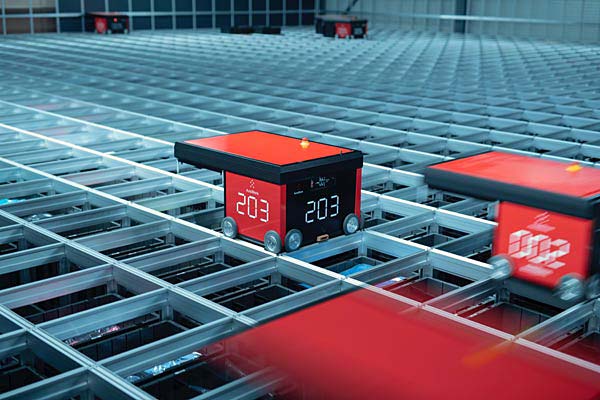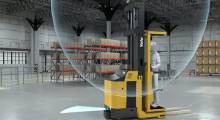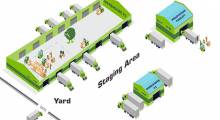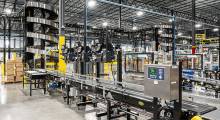Robots are hot in warehouses right now, with strong double-digit growth projected by most analysts over the next few years. There’s a big difference, however, between knowing that robotics has market momentum, and knowing how to properly scope an automation solution.
The dilemma with scoping robotics for a distribution center (DC) is that plenty of “it depends” are involved in finding a good fit. It depends on what warehouse workflow you want to automate. It depends on order mix and volume, product dimensions, layout and labor considerations. That said, if you back up from these parameters, some best practices emerge around knowing operational priorities, having a handle on data like stock-keeping unit (SKU) dimensions, and being clear about the problem.
“The No. 1 step is to look at what the dynamics of your business are, and where you might use robotics to improve your operations,” said Dwight Klappich, vice president of supply chain research at Gartner. “From there, you examine specifics like what’s the nature of the materials that need moving or handling, because moving a pallet with robotics is going to send you in an entirely different direction than doing collaborative picking of small items.”
Indeed, an operation can leverage many types of robotics, from fully autonomous lift trucks that can heft a pallet, to relatively small, aisle-based, collaborative mobile robots that guide humans through efficient picks. There are also goods-to-person mobile robot systems as well as robotic picking arms and associated software capable of picking “eaches” for e-commerce fulfillment.
While some robotics applications, like horizontal transport of a pallet, are fairly straightforward, others are more complicated and may involve an interplay of robotic systems, cell design issues, and the need for software tools to help users visualize performance and integrate with other systems. Particulars like dimensions, SKU velocity, or how many lines are typically in customer orders will influence what the best choice is, noted Klappich, as can whether the DC is new or a brownfield site.
“If you’re trying to retrofit robotics into a site with existing rack infrastructure that you don’t want to change, that can be an important factor,” said Klappich. “All these questions, as well as the fact that different robotics vendors might solve the same problems in different ways, are complexities many companies struggling with.”
Know your data
A good first step is knowing your SKU and order data, which sounds simple enough, but often isn’t, given frequent changes to SKUs and significant demand volatility this past year.
“Factors like dimensionality matter with robotics, and vendors are going to ask questions about order mix and the order velocity of your different SKUs, or about warehouse layout, like how wide your aisles are,” said John Santagate, vice president of robotics with Körber Supply Chain, which offers automation and warehouse management systems (WMS) and partners with multiple robotics vendors. “The more prepared a customer can be to answer those types of issues, the better when looking for robotics solutions.”
However, added Santagate, a prospective user operation needs to be ready with questions for robotics vendors, such as:
- In what type of DC environments and workflows has your robotics offering been most effective and why?
- How can your system scale to handle my volume peaks and my more normal volumes?
- For third-party logistics warehouses, how does the robotics solution accommodate multi-tenancy? How can a single fleet of robots support picking or other tasks on behalf of multiple clients?
To really understand the nuances between similar robotics offerings, it’s typically best to talk to multiple vendors and get them to explain how their systems offer a significant advantage for the workflows you want to concentrate on, Santagate advised.
“The vendors should be ready to define their points of differentiation, because for different customers, or even for the same customer for different workflows, those points of differentiation will help you identify where the best fit resides,” he said.
Other best practices include talking to a trusted third-party expert for guidance, said Santagate. Keep in mind that you may need more than one type of robotics to accommodate different types of inventory and workflows, just like a DC might have more than one type of fixed automation.
“I think the future involves distinguishing, within the four walls of your DC, what is the best fit type of automation for different segments of inventory,” said Santagate. “Don’t try to force fit one solution into every segment or scenario.”
Match robots to processes
Scoping out an appropriate robotics solution requires a solid understanding of order profiles and expected throughput levels, dimensions, inventory days on hand, as well as considering labor availability and productivity expectations, said Andrew Benzinger, business development manager at AutoStore, a robotic order fulfillment provider.
Other strategic drivers like DC network plans and the need for more space can also influence your robotics approach, as can a major shift to more direct-to-consumer e-commerce fulfillment, he said. A combination of factors may be drivers for automation. Once a company identifies what it wants to accomplish, it’s a matter of assessing data such as the order profile, throughput requirements, and available inventory on hand to properly configure a robotics solution.
“When we work with a new customer, we first understand why they’re reaching out in the first place to identify what they are really seeking to address, that’s step one,” Benzinger said. “From there, you have to get a feel for the data—it’s best to fully understand the size of each product, the days on hand for each item, and the throughput volumes. It’s very important to understand what the current state is, what the operational key performance indicators are, and how effective those processes are, to understand the value the automation will create.”
With AutoStore’s cube storage automation, dense storage of bins with robots on top of a grid storage structure retrieve and present bins to workstations or “ports” that can be operated by team members or robotic picking arms. Benzinger explained that robotic piece-picking software has advanced rapidly over the past 12 months, with about 12 DC sites in the U.S. that are pairing up AutoStore deployments with various picking arms.
The size of the cube and number of bins, the number of robots on top, and the number of ports on the side are all configurable elements, he added. They tend to vary by site depending on factors like dimensions, order volumes, and how many days on hand of inventory are in the DC for goods that go into the automation. “We lean heavily on experience and statistics to devise an appropriately sized system,” Benzinger said.
Another best practice is to size a robotics setup that can scale up to handle peak volumes, but not be underutilized the remainder of the year. The robotics vendor should be able to help establish tactics such as adding workstations or robots, said Benzinger.
“An understanding of the peak-to-average ratio for an operation is really helpful to determining how big the system should be,” he explained.
Start simple, but start
While prospective robotics users should be ready with answers on factors like product dimensions, layout and order profiles, robotics is flexible enough that with the right approach, its benefits can be tapped into quickly.
Rick Faulk, CEO of Locus Robotics, said his main piece of advice for managers contemplating use of mobile robotics is to start a project, since the technology is quick to deploy and can be acquired through robotics-as-a-service (RaaS), with very limited setup costs. “Just get started, and don’t be fearful of disruption,” said Faulk.
Locus Robotics’ collaborative multi-robot picking system uses existing storage and shelf infrastructure, he added. The Locus bots can reduce worker travel and increase the picking productivity by a factor of two or more, Faulk claimed. Thus, picking requires little or no change to storage, though it does typically call for some consideration of the impact of greater productivity on downstream processes, such as pack-out stations, he said. Such assessments can be done without getting bogged down with months of study, Faulk asserted.
“Some folks may think that with deployment of robotic solutions, you’ve got to reinvent the wheel and start all over, and that it’s going to cost you millions of dollars, but that’s just not the case,” he said. “Our advice is to look at what makes sense for your operation, keep it simple, and start automating without making a lot of infrastructure changes. Then over time, you can adjust some processes and make the solution better.”
To support fine-tuning of its solution, Locus conducts regular health checks on factors like picker productivity, slotting, throughput and other factors, leveraging a “heat map” view of activities the robotics software generates. Faulk explained that with these heat maps, rapid implementation, and periodic reviews, an operation can quickly see results without a drawn-out, traditional pilot program.
“We think of them as initial deployments rather than pilots,” he said. “We’ll do a full deployment, then look at the data two weeks in, 30 days in, 60 days in, and on a quarterly basis thereafter to optimize the system,” Faulk said. “The approach is more about continuous optimization, and not so much about running a pilot.”
No robot is an island
For piece-picking robotics, having a handle on product dimensions and weights, as well as throughput and SKU velocity requirements, is a crucial aspect of properly scoping a solution, and so is the design of the picking cell, according to Erik Nieves, CEO and co-founder of Plus One Robotics, which offers vision software for piece-picking robotics.
“If you are a new user, you have to ask practical questions like, ‘Where am I going to put this robot?’” said Nieves. “'Is it going to fit?’ A bunch of brownfield versus greenfield type questions need to be asked.”
For success with robotic picking, throughput goals should heavily influence your choice of robotic arm, since the lighter-duty collaborative robots can’t pick as fast as a bigger industrial robotic arm, said Nieves. The size and movement of a robotic arm and its weight will influence cell design, he added, so time spent on figuring out what arm is needed and close attention to cell design will help ensure that pick-and-place automation will have a smooth implementation.
“Any automation, even robotics, is still automation, so you still have to go through some degree of an engineering exercise,” said Nieves.
The ability of a robotics solution to manage exceptions is an important area to investigate with piece picking, he said. For instance, the same SKU may now has different packaging, which could cause problems picking a SKU that was easily picked before. The robotic software, Nieves adds, should be able to spot and resolve exceptions quickly.
Plus One Robotics’ vision technology allows for remote monitoring and support of the cells, so if a robotic arm gets perplexed by what it sees, the system notifies a “crew chief” support person from Plus One, who can remotely resolve issues. If the problem is physical in nature, like a ruptured carton or spilled contents, remote support can alert on-site maintenance personnel.
A robotic piece-picking solution should have some quality control functions built in to ensure proper placement to avoid problems downstream. For example, some of Plus One’s applications use a second camera to ensure correct placement.
“We can use a second camera for inspection, before we release that order downstream,” said Nieves. “We function as our own closed-loop quality control in these applications.”
Software steps up
Robotics vendors not only have software layers to help with fleet operations and path optimization, they also increasingly have dashboards and analytics that can be useful for managers. That makes asking about software functionality as important as hardware issues like payload capacity.
Vince Martinelli, head of product and marketing at RightHand Robotics, said technology has matured to a point where vendors and users are putting more emphasis on the operational considerations of running robotics at scale successfully. As a result, vendors are putting more emphasis on tools that help provide feedback on issues like any SKUs that are taking longer to pick than usual.
Martinelli explained a robotics cell may do just fine at picking a variety of SKUs into a tote, but the robotics software also needs to know how to properly place or arrange items into that tote to conform to downstream constraints or system considerations.
For example, an operation may want to have totes filled to a certain height to avoid items spilling out of the tote when conveyed on an incline. Doing that requires software intelligence to govern how the robot should place multiple items in a tote, or other situations like how to best place items into a moving tray, said Martinelli, so the sophistication of the “place” functions of a robotic picking solution can be just as crucial as the picking aspect.
“You don’t want the items to start to pile up randomly in a tote and create a tower of items that is prone to problems when the tote starts moving,” he said.
RightHand also offers software tools and reports to let an operation know if any SKU being picked is taking longer than normal or experiencing failed picks, so operations managers can investigate whether something has changed with the SKU, its packaging, or the way it’s being presented.
It could be that upstream from the robotics cell, a tote full of SKUs is now getting packed more tightly than before. This can pose problems for a piece-picking robot, whereas a human picker could use two hands to get an item out of a tightly packed tote.
At 6 River Systems (6RS), which offers collaborative mobile robots that work alongside human pickers, the software has grown to include an overarching set of analytics and visibility functions.
“It’s an intuitive cloud-based control center that can be used [not only] by supervisors in the warehouse, but also by executive staff in supply chain operations,” said Fergal Glynn, vice president of marketing at 6RS.
To make robotics work well over the life of the system, visibility and management tools have become increasingly important, he said, especially if it can do things like adjust the priorities of the robotic zone mid-shift if the analytics indicate that orders aren’t going be ready for a carrier pickup or miss some other deadline.
“It is real-time visibility, because the data is being generated by the robots and the pick activity happening on the warehouse floor,” said Glynn.
Operational effectiveness
Mitch Hayes, vice president for retail and e-commerce at Swisslog, agreed that having solid data on issues like product dimensions is essential to scoping the appropriate robotics. He noted that it’s also wise to assess the vendor’s industry track record and software functionality to address exceptions such as bins that come up short on inventory.
An operationally effective robotics system should be able to communicate with a WMS to trigger actions like cycle counts and any needed inventory corrections, said Hayes. Companies considering warehouse automation should ask about the exception handling between the robots and the WMS, or between the robots and the warehouse execution management (WEM) software. This calls for industry expertise from the vendor and software that addresses functions like opportunistic cycle counts.
“Robotics is more than what a robot arm moving at X speed or able to handle this size or weight item,” Hayes said. “There are also operational considerations to address.”
It also may be that a DC operation could benefit from more than one type of robot, which increases the need for providers that can work through interoperability among systems.
“Users need more than robotics technology—they need a vendor who can act as a chief engineer or a guru who can understand the metrics and data important to each system, and what the inputs and outputs should be for a robotic solution,” said Hayes.
If all of this sounds like a lot to chew on, it’s because it can be, acknowledged Klappich. To cope with the complexities of knowing what robots fit well different workflows or sites, as well as how they need to interact with the rest of the systems in a warehouse, Klappich said, some companies are beginning to create robotics centers of excellence (COE).
Such a COE would be a group of people within a company who’ve worked with robotics and also understand operational issues, and can guide managers. Some companies might even create a “chief robotics officer” to oversee the COE.
“The talent for these centers of excellence for robotics would be like a three-legged stool, with expertise in IT, engineering, and business and operations,” said Klappich. “Some companies are already moving in this direction. They recognize the need for an organization that can work with the business to align them with robots that would match up with their specific needs, and then can help them introduce a solution and support it.”
About the Author
Follow Robotics 24/7 on Linkedin
Article topics
Email Sign Up






















